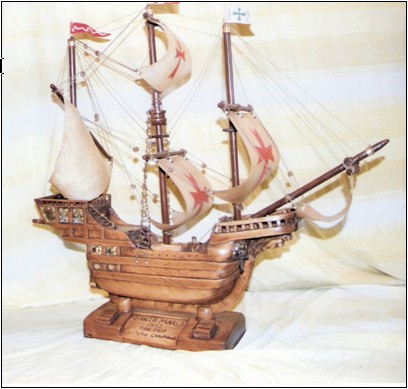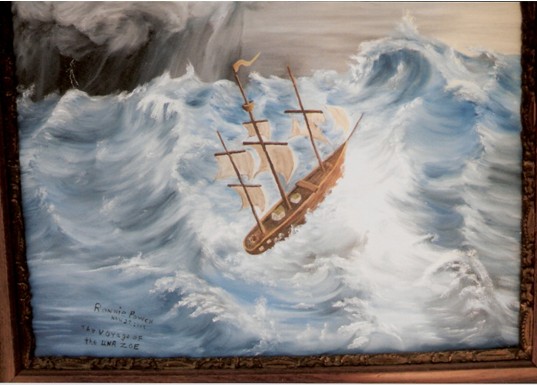It is a wonderful morning, a prelude to autumn. I am looking forward to this aspect of the year and to the winter or at least the first of it. The follwing story, Lady and the outlaw is fiction a product of my imagination. Lady is the most important part of it. She lived here in Windyville until her passing, a beautiful and gentle mare. The picture of her was created by my daughter Tammy. So if you are inclined to read the story I hope you enjoy it as much as I did writing it. There may be errors for I did not take a lot of time editing it. The next post will contaian the story of the Black and Tan Hound.
A pencil drawing of Lady
Lady and the Outlaw
The Pitts Cabin located in a small valley on the north bank of the Niangua River sat nestled on a high knoll overlooking the river. A granary, chicken house and barn rested on a lower slope a fair distance down from the cabin. A split rail fence enclosed the barn where Lady, a four year old gated mare stood sleepily switching flies beneath the drooping boughs of huge Elm tree. Cattle grazed below in an adjoining pasture along with two plow horses. An old rooster of considerable size stood in the doorway of the chicken house impatiently clucking, calling in two stray hens. Night, rapidly approaching brought forth the first of many choruses of wandering coyotes. The sound reverberated against the shadowed hills and bluffs along the Missouri Ozarks Niangua River.
Nine year old Emily, the youngest of eight children of Frank and Emma Pitts waited outside the two story log house until the last chicken entered their house and then ran down the hill and closed the door. Emily stopped at the corral with a chunk of molasses bread in hand and held it out to Lady.
“Pa says I can ride you down to the river and back in the morning.,” she said. I still can’t believe he gave you to me for my birthday. I love you Lady and have to go in now. I’ll see you in the morning.”
Night mist rising from the Niangua cooled the midnight air. A scent laden breeze stirring through the Elm brought forth a fluttering of birds roosting deep in the boughs of the old tree.
Whinnying softly; Lady pranced to the fence, the sleek body taunt as she searched the night air for tan elusive scent that troubled her. The scent was strong, coming from somewhere along the river. Again she whinnied, pawing the ground and began nodding. Suddenly the mare whirled and retreated under the tree and stood waiting. The scent of blood was now in the air.
A shadow figure appeared at the edge of a brush thicket not far from the corral and then began moving stealthily up the hill toward the corral. A shrill nicker burst from the mare and she moved deeper into the darkness around the tree. She watched silently the lone figure of a man duck below a top rail into the corral.
The man removed a bridle from a fence post near the gate, turned and walked slowly toward Lady. “Easy girl, he whispered. “It’s been a long day for me and I haven’t the strength to chase you around.”
The stranger reeked of blood, but the reassuring words of the man eased somewhat the fear in Lady and she stood quietly, warily observing the intruder. The man expertly tossed the bridle reins over Lady’s neck and just as quickly the bridle was slipped over her head. It was too late for Lady to flee.
The blood soaked left arm of the stranger hung useless at his side and the face of the man was pale and drawn and glistened with sweat. Flinching, the man moved toward the gate with reluctant Lady in tow. He stopped at the corral gate where a saddle and blanket sat astride the top rail of the fence. Mumbling incoherently he pulled the blanket down and laid it across the mare’s back and then hoisted the saddle across her back. The effort brought him to his knees and he sat for a moment blinded by the pain. Slowly he stood and with feeble strength pulled the cinch as tight as he could. With sheer will power he placed a foot in a stirrup and arduously swung astride Lady and slumped forward clinging to her mane. Agonizing seconds passed until he nudged the mare gently with a spur and she moved toward the gate.
Fear of the law and a hangman’s noose prevailed and he found strength to pull up the latch and the gate swung wide. Lady obediently moved outside the corral and with no further prodding of the spur she walked slowly past the dark window of the cabin and beyond into the gloom of the forest. The steady beat of her hooves faded into the night.
Dawn found Lady and the outlaw at the western edge of a timbered ridge overlooking the Lebanon, Fort Scott road. Twenty miles now lay behind the pair and soon they were moving quickly along the well traveled trace toward the Kansas border and perhaps freedom for the outlaw. Fear clung like sweat to his tortured body, for somewhere ahead the law might be waiting and would not hesitate to bring him in dead.
The wounded arm was now bound to the outlaw’s gun belt and lay useless across one leg. The gaunt weathered face of the outlaw bore the mark of extreme fatigue but his eyes were alert and carefully scanned the trail ahead. The reins hung from Lady’s neck, with his hand near the Colt forty five. He watched each rider they met with eyes shadowed under the wide brim of his hat.
When at last many miles lay back along the road, the outlaw took stock of Lady and gently patted her neck. “I hope you don’t mind ol gal, but we still got a long way to go before you can rest,” he said. “I robbed a bank in Lone Rock and a posse bent on taking me dead or alive durn near got me. They killed my horse. Blood thirsty they were, but dang I got away with two thousand dollars. That’s enough to buy me a spread and some cattle and I reckon you’ll be a part of it.”
At day break the next morning Lady and the outlaw cautiously entered the front street of Hanley, Missouri. Slumped forward, with the brim of his hat pulled down, the outlaw prodded Lady past a large mercantile store, saloon, barbershop and a small two story hotel. Further on they came to a weather beaten livery stable.
“Can I help you’ll, young feller?” a man called out from a front door of the stable. “You don’t look so good.”
“I got hurt yesterday,” the outlaw replied. “I need to board the mare for a couple of hours, while I see a doctor. “Is there one in town?”
“Yep, Doc Gann,” the man answered. “He’s got an office in a room of the hotel yonder. “I’ll see to your mare.”
“Give her a good brushing and a feed of oats and hay if you would,” the outlaw said and slowly dismounted. “Later tie her to that tee over there. What do I owe you?”
“Awe, two bits will do.”
Lady was lead into a stall and the saddle, blanket and bridle gentle removed. She stood quietly as the man groomed her. When finished the man poured her a generous helping of oats and place hay in the trough. The man stood quietly at her side and watched her hungrily eat the fare.
“I reckon there is more to your master’s injury than meets the eye,” the man said and turned to leave. “I have a feeling you don’t belong to him, but it ain’t none of my business. Do the best you can girl.”
Much later when afternoon shadows lay across the street near the old oak tree where Lady stood beneath its shade; the dappled sunlight catching the sheen of her coat. She gazed about uneasily, watching a man stagger from the saloon, haphazardly making his way toward her, cursing and yelling at nothing in particular. When it appeared he was intent on approaching her he stumbled and fell face down. Too drunk to stand he turned over and soon lay unconscious in the dust of the street.
Lady moved closer to the tree and snorted disapprovingly, patiently waiting for the return of the outlaw.
Nearing sundown the outlaw slowly made his way along the street toward Lady. Lady welcomed him with a shrill nicker pulling at the halter rope. The outlaw smiled and hurried to Lady’s side. He reeked of whiskey and appeared to be free of pain. His left arm was now heavily bandaged and secured to his gun belt.
“We got to be on our way,” he said. “It’s still a long way to Kansas.”
The following eight day were especially demanding for Lady, as they journeyed across the vast and seemingly continuous plain. The perpetual wind, dust, burning sun and sparse water bore heavily on both man and horse. Large herds of Buffalo could be seen in the distance, their scent alien to Lady. The scent of horses frequently attracted Lady, mingled with the strange smell of humans clothed in raw hide clothing. Many times during the passing of the other humans, the outlaw sought cover in the tall grass, pulling Lady to her knees, often hiding there for hours.
If not for yet another scent born on the wind, Lady would not have responded so quickly to spur and rein, for an instinctive urgency kept her moving, stirring in her a persistent restlessness. Often at night while standing hobbled, with head raised high, she searched the fleeting wind for a subtle fragrance that taunted the very essence of her being. She listened to the mysterious, elusive drumming of hooves far beyond the prairie. The high current of the wind teased her with a substance of choice more profound than she had ever known before. Often she would call out, to stumble against the hobble and then scolded by the outlaw. The further she traveled across the unbroken land the more intense the sensation became of strength and freedom like nothing she had never known before. It awaited her somewhere ahead.
Near the twentieth day of the journey as they neared the end of the prairie, an ominous appearing thunderhead met the pair near a high rise of stone and gullies. Rumbling from with in, flashing lightning, the fast approaching storm prompted the outlaw to find a safe cover from the storm. Dust devils skipped back and forth across the trail and sent a small herd of deer fleeing in all directions.
With little choice the outlaw laid the spurs to Lady up a steep slope in among the rocks. The wind blowing at gale force drove the pair deeper into the rock outcrop and down into a ravine where a bluff stood draped in vine. Dismounting, the outlaw led Lady beneath an overhang as large chunks of wood and other debris tumbled from the sky. The tail of a twister danced past the overhang and slowly ascended into the black sky. Exhausted by the day’s ride, the outlaw sat down and held a tight rein on the mare.
“The way you’ve been acting the last several days, I’m afraid to trust you,” the outlaw said to Lady. “I’cain’t imagine what has got into you. What is it that you see or hear out there?”
The storm past and Lady and the outlaw crossed a rapid moving stream then up a steep hill onto a broad muddy trace that would take them roughly westward. Several minutes later a building came into view and then another and ahead of the travelers a town came into view along a wide deeply rutted street. Instinctively the outlaw loosened the Colt in its holster.
The street was crowded with horses, wagons and people and no one appeared to take notice of Lady and the outlaw. But that ended abruptly when a tall man wearing a fancy black leather vest stepped out on the street. The man was armed with a pearl handled pistol stuck in the waste band of his trousers. A large nickel plated Marshal’s badge hung from the vest and glinted wickedly in the bright sunlight.
“Luke Shannon,” the man called out.
“Are you hollering at me?” The outlaw asked, pulling Lady to a halt.
“I reckon I am Luke,” the Lawman answered. “I got a wanted poster on you. Step down off the mare real easy.”
“What am I wanted for?”
“Bank robbery in Missouri,” the lawman answered.
”You got the wrong man Marshal; I ain’t never been in Missouri.”
“Get down off the mare boy. I ain’t gonna tell you again.”
Oblivious to the gathering crowd of people along the street,” the Outlaw ignored the warning and remained in the saddle staring down at the marshal. His right hand lay across his right thigh near the holstered Colt and then he drew the pistol with the speed of lightning. The slug from the Colt struck the Marshal in the chest.
The Marshal died instantly and fell backwards to the ground.
A bearded man wearing a yellow poncho moved to the edge of the boardwalk and brought up a single shot fifty caliber rifle and fired. The bullet hit Lady creasing a flank and she screamed and fell to her knees, only to be brutally brought back up by the outlaws spurs. Lady whirled and headed back down the street, running as fast as she could.
The bearded man fired the rifle once again, hitting the outlaw in the back, nearly unseating him. He grasped Lady’s mane and hung on swaying precariously in the saddle.
Driven by terror of the man and his rifle, Lady ran along the street, the reins torn and ragged dangling beneath her head. At the edge of the town she headed north westward over a high plain, beyond the settlement. The man called Luke and outlaw was no longer relevant.
Exhaustion finally brought Lady to a halt at the edge of a swollen creek and she stood with head down gasping for air. Lacking the strength to dismount, the outlaw fell to the ground and rolled over on his back. He drew from his belt a sheath knife and slowly reached up and cut the girth. He tried to sit up, but couldn’t and instead reached up and grasped the tattered reins, groaning piteously, completely blind now he pulled Lady’s head down and removed the bridle. He sank back on the ground, near death.
“I’m sorry girl,” he whispered hoarsely, “go now get out of here and find what you have been looking for out there in this God forsaken land.”
Sensing the presence of death in the man lying on the ground, Lady stepped away, dislodging the saddle and blanket and moved closer to the stream and without hesitation plunged into the swift current. Long powerful stokes took her quickly to the opposite side. She stood for a time searching the wind, with ears forward listening nodding as if anticipating what lay beyond.
Drawn again westward, Lady quickened her pace, stepping higher, faster, breaking into a gallop and then stretched out into a dead run. The motion was effortless of body and mind. A victorious mane and tail flowed in the wind. Ahead on the horizon she could perceive a bluish haze, a shimmering line so distant only a courageous spirit could perceive it. Further on in the distant mountains, images of her own kind beckoned her and among them stood one of strength that bore no mark of man, the essence of freedom and rebirth.
Adios






























